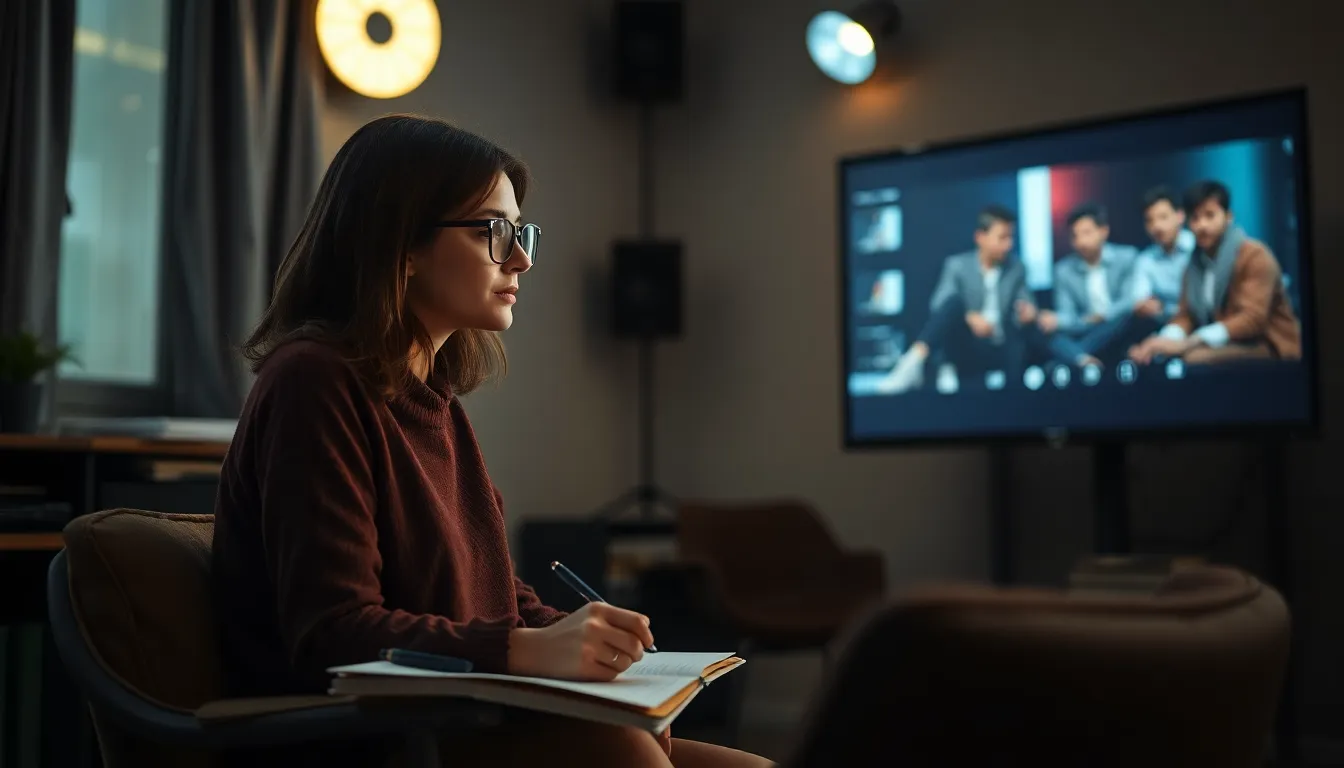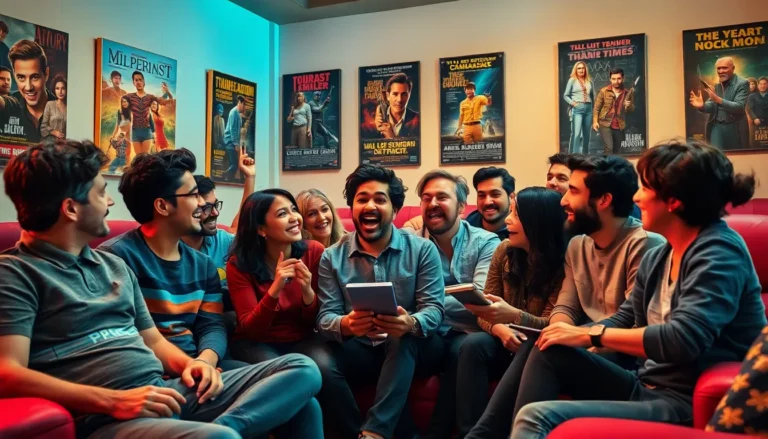Film critique isn’t just for the pretentious cinephiles sipping espresso in dark theaters. It’s for anyone who’s ever laughed, cried, or rolled their eyes at a movie. Whether it’s a blockbuster or an indie gem, dissecting films can be as thrilling as the plot twists themselves. Think of it as a treasure hunt where every frame holds a clue to what makes a film tick—or tock if it’s a bad one.
Table of Contents
ToggleUnderstanding Film Critique
Film critique serves as an accessible avenue for exploring and appreciating cinematic works. By analyzing films, individuals uncover various aspects of storytelling and filmmaking.
Definition of Film Critique
Film critique entails evaluating and interpreting movies. This process involves examining elements such as direction, acting, cinematography, and editing. Critics often articulate their opinions on narrative structure and thematic depth. Many critiques involve an audience’s emotional responses and engagement with the film’s content. Understanding film critique empowers individuals to appreciate artistic choices and narrative techniques in a nuanced way.
Importance of Film Critique
Film critique holds significance for several reasons. It enhances viewers’ understanding of cinematic language and artistic expression. Engaging with critiques fosters critical thinking skills as viewers analyze and assess films. Critics also contribute to the broader discourse about cultural narratives and social messages presented in films. The importance of film critique lies in its ability to influence audience perspectives and encourage meaningful conversations about the art of filmmaking.
The Elements of Film Critique

Film critique involves analyzing various aspects that contribute to a movie’s overall impact. Understanding these elements enhances the viewing experience and develops critical awareness.
Narrative Structure
Narrative structure serves as the foundation of a film’s story. It dictates how events unfold and shapes viewer engagement. Common elements include exposition, rising action, climax, falling action, and resolution. A well-crafted narrative structure creates tension and motivates character actions. Understanding how filmmakers manipulate time and perspective adds layers to the interpretation. Evaluating conflicts and character arcs reveals thematic depth. The structure must effectively connect plots to evoke emotion or provoke thought.
Cinematography
Cinematography encompasses the visual composition of a film. The choice of camera angles, shot composition, and lighting plays a vital role in storytelling. Different techniques, such as handheld shots or wide-angle lenses, affect viewer perception and emotional response. Color palettes convey mood and tone, while contrast can highlight significant details. A coherent cinematographic strategy enhances narrative connections. Analyzing these visual elements fosters appreciation for artistic choices and technical skill. Ultimately, cinematography transforms the viewer’s experience by creating a cohesive visual language.
Performance Analysis
Performance analysis focuses on the actors’ portrayals of their characters. Delving into body language, facial expressions, and vocal delivery reveals the intricacies of a performance. Actors embody their roles, often bringing depth to superficial scripts. Evaluating the chemistry between actors can enhance or detract from emotional impact. Key performances resonate with audiences, often influencing critical reception. The ability to assess these components aids in understanding character motivations and emotional journeys. Rich performances engage viewers, fostering connection to the story being told.
Different Approaches to Film Critique
Film critique encompasses various methods, catering to diverse audiences and perspectives. Two prominent approaches are academic film critique and popular film critique, each with distinct characteristics.
Academic Film Critique
Academic film critique focuses on theoretical frameworks and scholarly analysis. Critics often utilize concepts from film theory to examine elements like narrative structure and visual aesthetics. This method encourages in-depth exploration of a film’s cultural and historical context. Scholars analyze how a film reflects or challenges societal norms, providing a nuanced understanding of its impact. Research-backed evaluations often engage with established film literature, creating a dialogue with previous works. This approach enhances critical thinking and establishes a foundation for understanding the complexities of cinema.
Popular Film Critique
Popular film critique emphasizes accessibility and relatability. Critics in this realm often target general audiences, providing insights that resonate with everyday viewers. Reviews typically highlight entertainment value, emotional engagement, and overall enjoyment. This approach prioritizes personal impressions and broader cultural relevance. Critics may discuss themes, performances, and cinematography in a conversational tone, making critiques engaging and approachable. By fostering dialogue through social media platforms and blogs, popular film critique encourages viewer participation and shared experiences.
Applying Film Critique Practically
Engaging in film critique enhances appreciation for cinema. It allows viewers to delve deeper into films.
Tips for Writing a Film Critique
Start by summarizing the film’s plot clearly. Include main characters and key events to provide context. Focus on one specific element of critique, like acting or cinematography, to develop depth. Use concrete examples from the film to support personal opinions. Balance subjective impressions with objective analysis for clarity. Engage with other critiques to broaden perspectives and enrich understanding.
Common Mistakes in Film Critique
Overgeneralizing can dilute an argument. Avoid vague statements that lack supporting evidence. Allowing personal bias to overshadow analysis detracts from credibility. Ignoring technical aspects, such as sound design or editing, can overlook critical elements of storytelling. Failing to consider the film’s context or genre may lead to misinterpretation. Lastly, neglecting to proofread can result in errors that affect readability.
Engaging with film critique opens up a world of understanding and appreciation for cinema. By exploring the various elements that contribute to a film’s impact, viewers can develop a richer perspective on storytelling and artistic choices. Whether adopting an academic or popular approach, the insights gained from critique enhance the viewing experience and stimulate meaningful discussions.
As individuals delve into the nuances of narrative structure, cinematography, and performance, they cultivate critical thinking skills that extend beyond the screen. This journey not only fosters personal growth but also encourages a collective exploration of cultural narratives and social messages. Embracing film critique empowers everyone to become more discerning viewers and active participants in the cinematic conversation.




